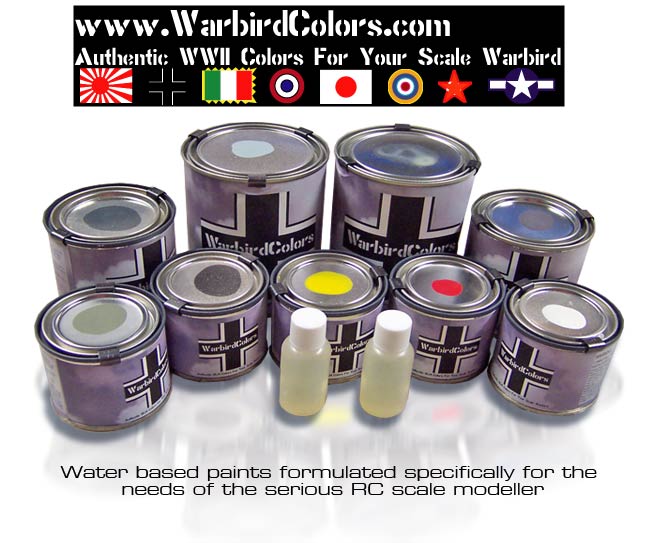
I used Warbird Colors water-based paints to do all my primary painting, which included the tri-color splinter chamo scheme and all insignias/markings. After my experiences with shooting Latex house paints on my SBD, I knew I wanted to stick with water-based paints again. I had heard so much about Warbird Colors that I felt it was worth looking into and decided to talk to Chuck Graves at WC to see if these paints were going to be right for this project.
About Warbird Colors paints
Warbird Colors primers and paints are water-based polyurethane coatings designed specifically for model aircraft builders. Utilizing state-of-the-art spectrometer analysis, WC paints have been color matched to the colors utilized by the countries involved in WWII. Warbird Colors provide a safe, simple to use and authentic color match for scale warbirds.
WC primers and paints are water-based, therefore they are non-flammable and thus safe to use indoors. Additionally they are low in VOC (volatile organic compounds, or thinners), low odor and clean up easily using water. WC paints can be applied over all materials encountered in scale modeling such as fiberglass, wood, metal, and fabric coverings. They can be applied using a brush, standard spray equipment, a HVLP spray system or via airbrush.
With any paint job, the quality of the final finish is directly proportional to the quality of surface preparation done prior to painting. Surfaces must be sanded to a smooth finish and all holes, dings, gaps, etc. must be filled with the appropriate material and sanded. Wooden surfaces must be covered with fiberglass or some form of covering , etc. and sealed with epoxy resin, dope, or PolyCrylic finish. Failure to do so may cause the wood to expand or warp, and possibly split along the wood grain due to the water present within the paints.
All fiberglass and molded plastic parts should be sanded lightly using a fine-grit sandpaper and washed and wiped clean prior to painting to remove any parting agents and surface residues, and provide a clean bonding surface for the paints.
Covalent bonding agent
Warbird Colors paints are designed to be used with a covalent bonding agent, or "crosslinking additive." It is the addition of this bonding agent or crosslinker which gives WC paints the additional property of resistance to model airplane fuels (including gasoline). Proper usage of this crosslinker will provide fuel proofing for model airplane fuels containing up to 15% nitromethane content. The crosslinker must be added to the paint in the amount of 8 drops of crosslinker per one ounce of paint.
The crosslinking additive also acts as a catalyst or hardener. Therefore you should only mix the amount of paint to be used within a short period of time. Once the bonding agent is added to WC paint, it can only be stored for a limited amount of time before it will begin to harden or jell. During the painting process, it may be necessary to clean the spray tip of your paint gun to eliminate clogs, spattering etc. and ensure a smooth finish.
Which colors?
For this project, the following list of WC paints were used...
Entire Bottom & Fuse Sides – RLM 76
Top – Camo Pattern of RLM 74 & RLM 75
Cowl Bottom – RLM 04
Cowl top – Alternating Stripes of RLM 21 & RLM 22
Rear Fuse Band – RLM 23
Flaps and Wheel Wells – RLM 02
Wheels – RLM 70
Entire plane - Satin Clear Coat |
|